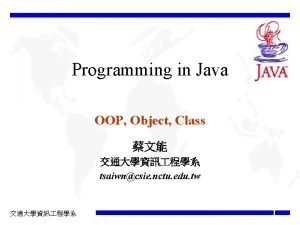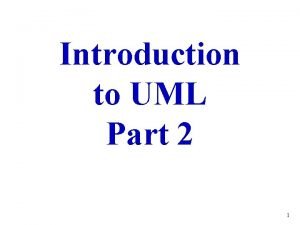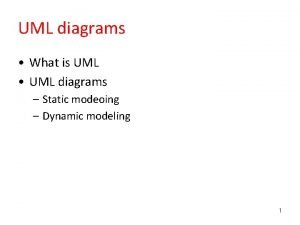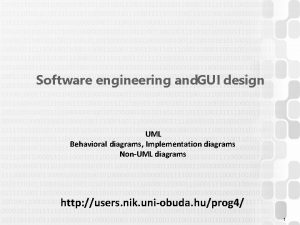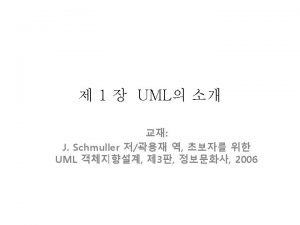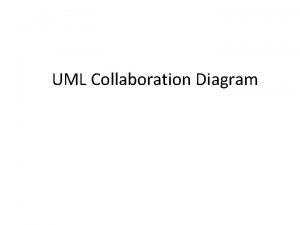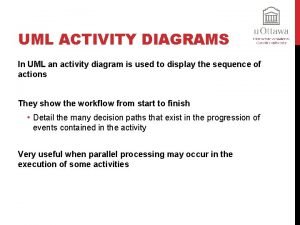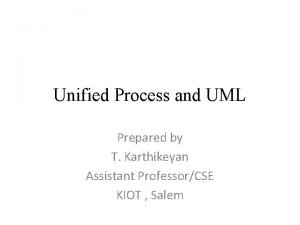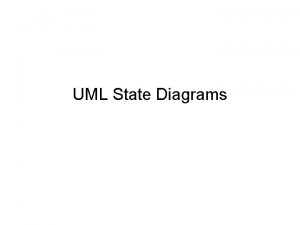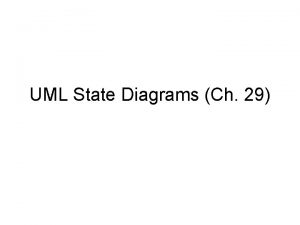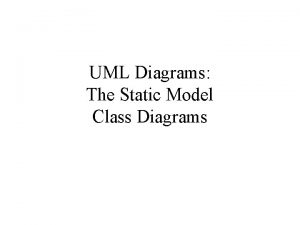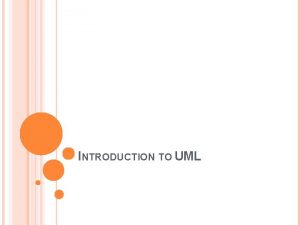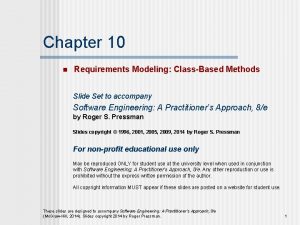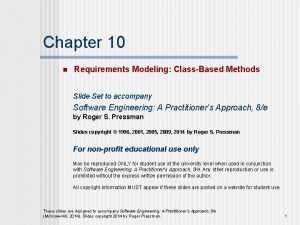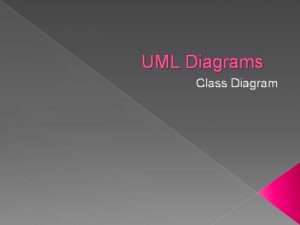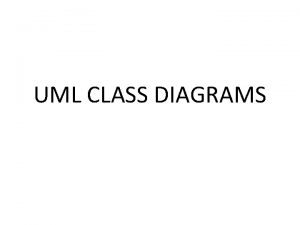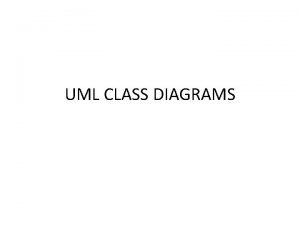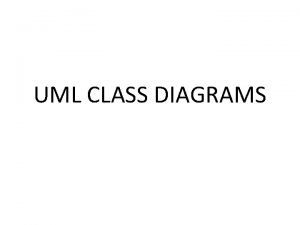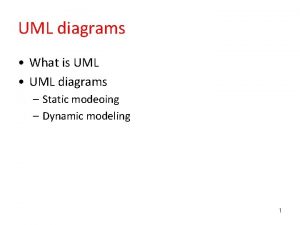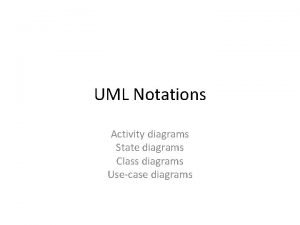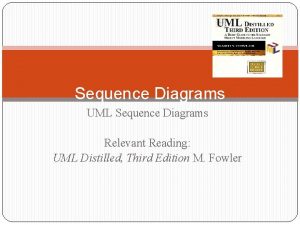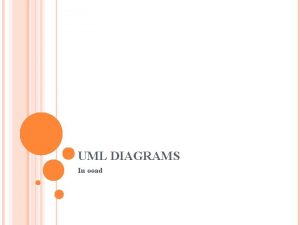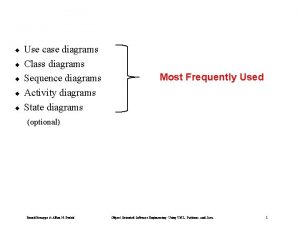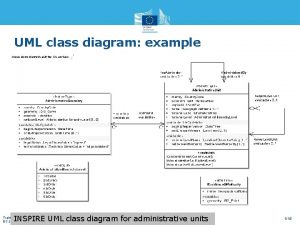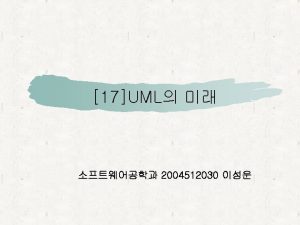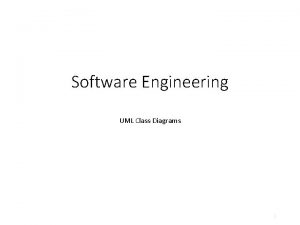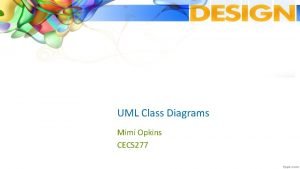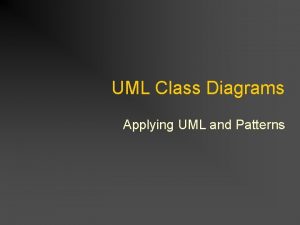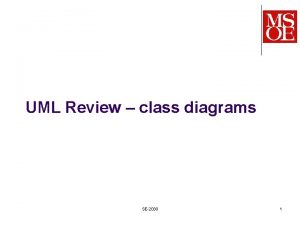Software Engineering UML Class Diagrams 1 UML Example









![Class diagram example 3 Student. Body + main (args : String[]) 1 100 Student Class diagram example 3 Student. Body + main (args : String[]) 1 100 Student](https://slidetodoc.com/presentation_image_h2/af60dc9a831b0e415930ddaef52f84fb/image-10.jpg)












- Slides: 22

Software Engineering UML Class Diagrams 1

UML Example of a Class • attributes (fields, instance variables) • visibility name : type [count] = default_value • visibility: + # ~ public protected private package (default) • underline static attributes • derived attribute: not stored, but can be computed from other attribute values • attribute example: - balance : double = 0. 00 2

Class operations / methods • visibility name (parameters) : return_type • visibility: + public # protected private ~ package (default) • underline static methods • parameter types listed as (name: type) • omit return_type on constructors and when return type is void • method example: + distance(p 1: Point, p 2: Point): double 3

Comments • represented as a folded note, attached to the appropriate class/method/etc by a dashed line 4

Relationships between classes: • generalization: an inheritance relationship • inheritance between classes • interface implementation • association: a usage relationship • dependency • aggregation • composition 5

Generalization relationships • generalization (inheritance) relationships • hierarchies drawn top-down with arrows pointing upward to parent • line/arrow styles differ, based on whether parent is a(n): • class: solid line, black arrow • abstract class: solid line, white arrow • interface: dashed line, white arrow • we often don't draw trivial / obvious generalization relationships, such as drawing the Object class as a parent 6

Associational relationships • associational (usage) relationships 1. multiplicity (how many are used) • • * 1 2. . 4 3. . * 0, 1, or more 1 exactly between 2 and 4, inclusive 3 or more 2. name (what relationship the objects have) 3. navigability (direction) 7

Class diagram example 1 Textbook Rental System visibility Customer -CID: int -name: String +authenticate. Customer () attributes multiplicity 1. . * rents 1. . * class name Textbook -book. ID : int -book. Volume. No: int +rent. Book() relationship methods

Class diagram example 2 Multiplicity Customer Class Simple 1 Aggregation Rental Invoice Abstract Class Rental Vehicle 1. . * 1 0. . 1 Composition Simple Generalization Car 9 Association SUV Moving. Van Checkout Screen
![Class diagram example 3 Student Body main args String 1 100 Student Class diagram example 3 Student. Body + main (args : String[]) 1 100 Student](https://slidetodoc.com/presentation_image_h2/af60dc9a831b0e415930ddaef52f84fb/image-10.jpg)
Class diagram example 3 Student. Body + main (args : String[]) 1 100 Student - first. Name : String last. Name : String home. Address : Address school. Address : Address + to. String() : String Address - street. Address : String city : String state : String zip. Code : long + to. String() : String

Tools for creating UML diags. • Lucidchart • http: //www. lucidchart. com/ • Rational Rose • http: //www. rational. com/ • Visual Paradigm UML Suite (trial) • http: //www. visual-paradigm. com/ • (nearly) direct download link: http: //www. visual-paradigm. com/vp/download. jsp? product=vpuml&edition=ce (there are many others, but most are commercial) 11

Topics • Process 12

Review

OOP Analysis Process • Four-step Process

Step 1 The first step is to obtain or prepare a textual description of the problem to be solved.

Step 2 Examine the description and underline nouns. The nouns will become classes in the analysis.

Step 3 Examine the description and underline adjectives in the document. These adjectives will describe the attributes of the classes that we previously identified.

Step 4 • Analyze the active verbs in the description. • The active verbs will give us the operations (methods) that we'll need to define for our classes.


Problem You have been tasked with creating an online shopping website. Users can add more than one item on sale at a time to a shopping cart. What elements should be modeled as classes? • Item • Rating • Price • Shopping. Cart • Time • User

Practice

Course Management System 1. The Registration Manager sets up the curriculum for a semester using a scheduling algorithm. 2. One course may have multiple course offerings 3. Each course offering has a number, location, and time. 4. Students select 4 primary courses and 2 alternative courses by submitting a registration form. 5. Students may use the system to add/drop courses for a period of time after registration. 6. Professors use the system to receive their course offering rosters. 7. Users of the registration system are assigned passwords, which are used at login validation. Build the Class Diagram
 Use case model
Use case model Uml activity diagram tutorial
Uml activity diagram tutorial Uml class diagram inner class
Uml class diagram inner class Uml building blocks in software engineering
Uml building blocks in software engineering Uml class diagram
Uml class diagram Uml adalah
Uml adalah Uml class diagram static
Uml class diagram static Behavioral diagrams
Behavioral diagrams Uml org
Uml org Collaboration diagram
Collaboration diagram Activity diagram expansion region
Activity diagram expansion region Introduction of gym management system
Introduction of gym management system Pos uml diagrams
Pos uml diagrams State diagrams uml
State diagrams uml Pos uml diagrams
Pos uml diagrams Include extend use case
Include extend use case Uml static class
Uml static class Things are explantory parts of uml model
Things are explantory parts of uml model What is system in software engineering
What is system in software engineering Forward engineering in software engineering
Forward engineering in software engineering Class based modeling in software engineering
Class based modeling in software engineering Class based modeling in software engineering
Class based modeling in software engineering Modality in software engineering
Modality in software engineering


